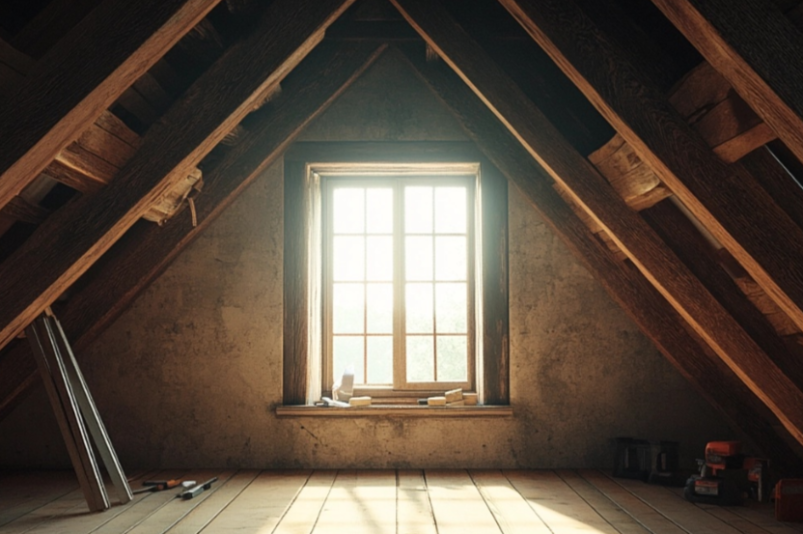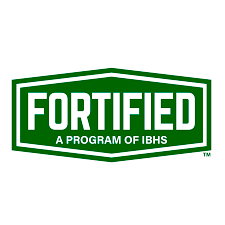
A truss roof is like the backbone of a building’s hat. It’s a pre-built framework made of triangles—strong, lightweight, and designed to hold up your roof and keep everything sturdy. Unlike the old-school way of cutting rafters one by one, trusses are built in a factory and come ready to install. You’ll see them used on everything from small homes to big warehouses because they’re efficient and cost-effective.
How Does a Truss Roof Work?
A truss roof is built on the principle of triangles because they’re the strongest shape you can use in construction. When a load—like the weight of shingles, snow, or even a person—is applied to the roof, the triangular structure spreads that weight evenly across the truss. This design prevents any one part of the roof from taking on too much pressure, which could cause sagging or failure.
Here’s the breakdown:
- Top Chords: These are the sloped beams that form the roof’s pitch. They take the majority of the downward pressure.
- Bottom Chord: This is the horizontal beam connecting the base of the triangle. It resists pulling forces and also acts as a ceiling joist.
- Webbing: The braces inside the triangle connect the top and bottom chords. They redirect and balance the forces, ensuring the load is spread evenly.
When they work together, these parts create a structure that can handle much heavier loads than a traditional stick-built roof while using less material. It’s also why trusses can span longer distances without needing interior walls or columns for support.
Types of Truss Roofs
Not all trusses are built the same, and which one you need depends on your house’s design and what you’re trying to achieve. Here are the ones you’re most likely to run into:
- King Post Truss: The simplest design with a single vertical support in the middle. Great for smaller spaces like porches or sheds.
- Scissor Truss: These have angled bottom chords, creating vaulted ceilings. Perfect if you want to open up a room without adding extra weight.
- Fink Truss: The most common truss you’ll find in residential homes. It’s designed to handle medium to long spans and looks like a webbed triangle.
- Attic Truss: This one has a built-in space for an attic or storage area. You get the best of both worlds: strength and extra usable space.
The type of truss matters because each design spreads weight differently. Choosing the wrong one can lead to sagging or even structural issues, so always match the truss to the job.
Benefits and Challenges of Truss Roofs
A truss roof offers plenty of advantages, but it’s not without its trade-offs. Understanding both sides will help you decide if it’s the right choice for your home.
One of the biggest perks is how cost-effective trusses are. Since they’re prefabricated in a factory, they don’t require as much labor on-site. This not only saves money but also speeds up the construction process, so your project wraps up faster. On top of that, the triangular design makes them incredibly strong and durable, distributing weight evenly across the structure. This is why trusses handle heavy snow loads or strong winds better than traditional stick-built roofs.
Another standout feature is their versatility. Trusses can be customized to fit almost any roof design, whether you want vaulted ceilings, attic space, or long spans that don’t need interior support beams. For modern homeowners, that flexibility is a big selling point.
However, there are some challenges to consider. Once a truss is built, it’s set in stone—literally. On-site adjustments aren’t possible, so any design changes must happen before fabrication. They’re also large and sometimes tricky to transport and handle, especially if the building site has limited access. And if you’re opting for wooden trusses, you’ll need to factor in treatments to protect against moisture and pests, which can add to maintenance costs over time.
Common Questions Homeowners Ask About Truss Roofs
When it comes to truss roofs, homeowners tend to ask a few key questions during the building or remodeling process. Here are the ones that come up most often:
How Much Do Truss Roofs Cost?
The cost of a truss roof depends on factors like the size of the roof, the materials used, and the complexity of the design. Wooden trusses are usually more affordable upfront, but they may require regular maintenance. Steel trusses are pricier but offer greater durability and fire resistance. On average, expect to pay between $40 and $70 per truss for standard designs, but custom or larger trusses can cost significantly more.
Can Truss Roofs Support Additions Like Solar Panels?
Yes, most truss roofs can handle solar panels or other additions, but it depends on how they’re designed. If you’re planning to install panels or other heavy equipment, let your contractor or engineer know during the design phase. They’ll ensure the trusses are built to handle the extra weight.
Are Truss Roofs Easy to Maintain?
Truss roofs require very little maintenance compared to traditional rafter roofs. Regular inspections to check for damage, proper ventilation to prevent moisture buildup, and ensuring pest treatments (for wooden trusses) are the basics. Steel trusses are even lower maintenance but should be inspected for rust or corrosion over time.
Is a Truss Roof Right for Your Home?
Truss roofs are one of the most practical and reliable options for homeowners. They’re strong, cost-effective, and can be tailored to fit almost any home design. If you’re building new or replacing an old roof, trusses make the process faster and more efficient. However, the key to getting it right is in the planning. Give us a call at Presidio Roofing about your specific needs—whether it’s attic space, solar panels, or a vaulted ceiling—so your trusses are built to fit your vision.
At the end of the day, truss roofs combine modern engineering with practical design, making them a smart choice for almost any project.





